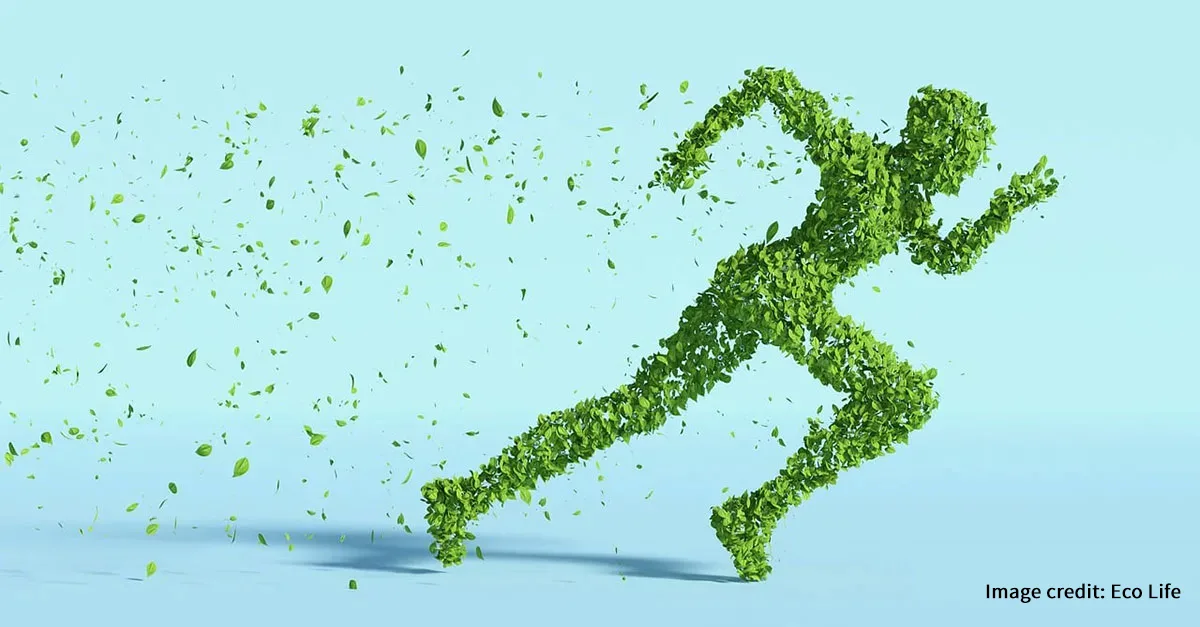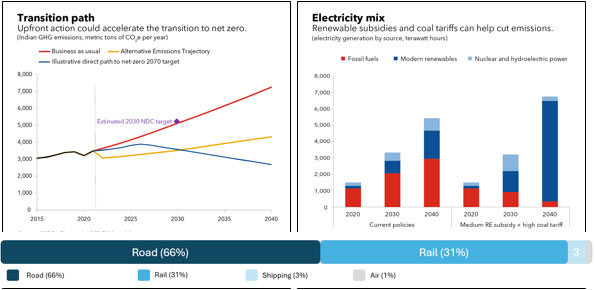Find the programme that meets your requirements and aspirations.
Apply nowStudent Blogs
- SPJIMR
- Blog
- Sustainable Futures: India’s development journey, coupled with sustainability
Sustainable Futures: India’s development journey, coupled with sustainability

Image Credit: Eco Life
Understanding the dynamics of economic growth and sustainability
India has risen from 13th to the 5th largest economy globally, showcasing remarkable economic growth, and thus has set ambitious goals for sustainable development.1
As a country grows, it consumes more resources, leading to a rise in energy levels, resource consumption, wastage, and habitat destruction. There is also an over-exploitation of the resources. More industries emerge to meet the demands of the consumers leading to even further resource consumption and wastage. To balance the growth and ensure that it is prevalent in the long run as well, sustainable practices are utmost necessary; otherwise, this growth will only be a short-term phenomenon2. Hence sustainable practices like “resource-efficient technologies and circular economies”2, etc are necessary to ensure the long-term growth of a country.
Targets set by India in Budget
India focused on “Green Growth” for the first time to meet the Net Zero targets by 2070.3 Various programmes and initiatives have been planned by India to meet the targets which include the Green Credit Programme, Rs 35,000 crore for priority capital investments towards energy transition, Green Hydrogen Mission, GOBARdhan scheme, etc.4
Way forward
To ensure that the country is growing as well as meeting its sustainable targets, India needs to focus on proper subsidy planning, transformation of its logistics infrastructure, sustainable agriculture, and advancing energy solutions.
I Subsidy planning
India is making significant progress in meeting the emissions reduction under the Paris Agreement; however, if it continues with the existing policies, the GHG emissions will increase by approx. 40% by 2030, which exceeds the target set by India4. Even though India may implement short-term measures to curb the same, however, to ensure long-term success, it is imperative to focus on changing the existing policies. The government will have to provide subsidies for switching to green energy and will have to increase the taxes on emissions and reduce the dependence on imported fuels. IMF has suggested that India “combine renewable subsidies and higher tariffs on coal (roughly equivalent to ramping up India’s existing excise duty on coal)”5 to showcase greater benefits for the country in meeting its goals and ensuring growth.

II Logistics Transformation
According to The Economic Times, the Indian logistics market grew from $190 billion in 2019 to $435.43 billion in 2023 and is set to touch $650.52 billion in the next five years at a CAGR of 8.4%”5. The logistics industry is the backbone of India’s economic growth.
As per the Times of India, “India moves around 4.6 billion tonnes of freight, which creates a need for transport that covers 2.2 trillion tonne-kilometers, emitting 2.3 gigatonnes of carbon dioxide (CO2).”6 As per reports, India’s freight movement is heavily skewed, reference the chart below:
“India is 3rd in the world for CO2 emissions, preceded by China and the United States.”7 The government of India is coming up with various policies like Gati Shakti, etc. to reduce the same and streamline the logistics industry. States are also participating actively, for example, “Pune dedicates substantial budgets to support sustainable transport projects, such as Bus Rapid Transit Systems (BRTS) and green fuel initiatives”3.
Successful implementation of policies will help ensure India reduces its CO2 emissions and help India achieve the target of Net Zero by 2070 with economic growth.
III Sustainable agriculture
“Agriculture contributes ~17% to the total GDP and employs ~58% of the population”7. In India, agriculture plays a pivotal role, as even though the country is shifting to services, a majority of the population is employed in agriculture. As per 2021 data, “India’s farm sector accounts for 14% of the country’s total GHG emissions, preceded by electricity (44%), and manufacturing industries and construction sectors combined (18%).”8
Thus, it is of utmost necessity that sustainable agricultural practices are in place to ensure that CO2 emissions are reduced. The challenges of “fragmented landholdings and over-reliance on monsoons, requires adoption of climate-resilient agriculture.”3 Huge investments are required to ensure that sustainable agriculture practices are in place, the role of startups to integrate robots in agriculture, use of Artificial Intelligence, and Machine Learning can be taken advantage of to reduce emissions as well.
IV CSR spending on sustainability
“As per segregated (provisional) data by the Ministry of Corporate Affairs (MCA), spending on health stood at Rs 9,987 crore in FY22, against Rs 8,382 crore on education. Environment was at Rs 2,837 crore in FY22, more than double from Rs 1,337 crore in FY21.”9
The companies are shifting to spending their CSR funds on the environment, to ensure long-term growth. This is of utmost necessity since “India needs over $1.5 trillion in climate investments between 2020 and 2030 across sectors like transport, energy, sustainable agriculture, waste management, and city resilience to minimize the impacts of climate change.”10 Private investment can accelerate this by a large margin and ensure the funds are invested in the right and productive places.
Conclusion
In conclusion, India’s impressive economic ascent from the 13th to the 5th largest global economy is accompanied by challenges like resource strain, and environmental degradation. The government’s commitment to ‘Green Growth’ and Net Zero targets by 2070 reflects a pivotal shift toward sustainability, evident in budget allocations for initiatives like the Green Credit Programme and Green Hydrogen Mission.
To ensure a harmonious balance between growth and sustainability, India must chart a strategic way forward. The focus on logistics transformation, with initiatives like Gati Shakti, aims to streamline the industry, reduce carbon emissions, and contribute to the Net Zero target. The significant growth in the logistics market underlines its pivotal role in India’s economic landscape.
Sustainable agriculture, a key pillar for India’s future, requires climate-resilient practices and technological investments to mitigate greenhouse gas emissions.
CSR spending emphasizes the private sector’s role in long-term growth. Shifting the focus to environmental initiatives, companies contribute significantly to India’s climate goals. Private investment, aligned with government efforts, can drive the transition towards a more sustainable and resilient future.
Essentially, the balance between growth and sustainability is not just an economic necessity but a moral imperative for India. By strategically aligning policies, leveraging technology, and fostering collaboration between government, businesses, and the public, India can not only achieve its growth targets but also emerge as a global exemplar of sustainable development. The path to a greener, more prosperous India requires collective effort and a commitment to leaving a legacy that benefits both the present and future generations.
1 https://www.ey.com/en_in/climate-change-sustainability-services/how-india-can-balance-growth-and-sustainability-in-its-net-zero-journey
2 https://www.moneycontrol.com/news/trends/features/balancing-economic-growth-and-sustainability-navigating-the-nexus-of-prosperity-and-planet-11444961.html
3 https://www.businesstoday.in/union-budget/news/story/budget-2023-fm-nirmala-sitharaman-pushes-for-green-reforms-focuses-on-indias-net-zero-target-368466-2023-02-01
4 https://www.imf.org/en/News/Articles/2023/03/06/cf-india-can-balance-curbing-emissions-and-economic-growth
5 https://www.corpseed.com/knowledge-centre/the-future-of-indian-logistics-a-roadmap-to-transformation#:~:text=Roadmap%20to%20Logistics%20Transformation%20of%20India,-India’s%20logistics%20sector&text=Collaboration%20with%20the%20stakeholders%20is,in%20reducing%20costs%20or%20efficiency
6 https://timesofindia.indiatimes.com/blogs/voices/navigating-indias-logistics-sector-towards-sustainable-future-strategies-for-carbon-emission-reduction/
7 https://testbook.com/articles/contribution-of-agriculture-in-gdp#:~:text=Role%20of%20Agriculture%20in%20Indian%20Economy&text=The%20contribution%20of%20agriculture%20to%20GDP%20rose%20to%2019.9%25%20in,GDP%20was%20in%202003%2D04
8 https://www.hindustantimes.com/india-news/india-aims-for-better-practices-to-cut-agri-emissions-experts-call-for-clear-goals-101637068230083.html
9 https://www.financialexpress.com/policy/economy-csr-funding-getting-pro-climate-one-small-step-at-a-time-3305109/
Recent Posts
- #DoCCDiaries: Community springs in the Bag Guler Panchayat July 9, 2024
- Experiential learning: My month-long advocacy internship with PGDM’s DoCC June 25, 2024
- My journey: Transforming lives through Abhyudaya June 6, 2024
- Discovering cutting-edge applications of AI and ML in the finance sector June 4, 2024
- #DoCCDiaries: Durbar: Fight against stigma for ‘dignity of profession’ May 28, 2024

